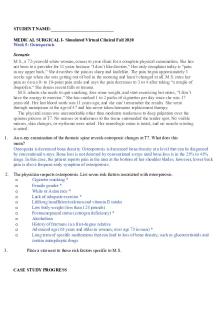Casestudy - tutorial PDF

| Title | Casestudy - tutorial |
|---|---|
| Author | jaya prasanna |
| Course | Human Computer Interaction |
| Institution | Anna University |
| Pages | 4 |
| File Size | 213.8 KB |
| File Type | |
| Total Downloads | 25 |
| Total Views | 135 |
Summary
tutorial...
Description
Chapter 3 Case Studies
Case Study Focus • Applications generally can be divided into 3 layers
– User interface – Application logic – Other components/layers • Focus on application logic layer because:
2
Sample Layers & Objects in OO System
minor focus
User Interface explore how to connect to other layers
primary focus of case studies
application logic layer
Sale
Payment explore how to design objects
other layers or components
Logging ...
secondary focus
Database Access ...
Learning Path Following Iterations
Iteration 1 Iteration 2 Introduces just those analysis and design Additional analysis and skills related to design skills introduced. iteration one.
Iteration 3 Likewise.
Case Study I: NextGen POS System • NextGen point-of-sale (POS) system – Computerized application used (in part) to record sales and handle payments typically used in a retail store
• Components – Hardware: computer and bar code scanner etc. – Software
• Interfaces to various service applications, such as a thirdparty tax calculator and inventory control • Must be relatively fault-tolerant – Even if remote services are temporarily unavailable (such as the inventory system), they must still be capable of capturing sales and handling at least cash payments
• Increasingly must support multiple and varied client-side terminals and interfaces – – – –
Thin-client Web browser terminal Regular personal computer with graphical user interface Touch screen input Wireless PDAs, etc.
Case Study I: NextGen POS System • Sold to different clients with disparate needs in terms of business rule processing • Each client will desire a unique set of logic to execute at certain predictable points in scenarios of using the system, such as – When a new sale is initiated – When a new line item is added
• Need a mechanism to provide flexibility and customization. • Using an iterative development strategy, we are going to proceed through requirements, object- oriented analysis, design, and implementation.
Case Study II: Monopoly Game System
• Domain and requirements not at all like business system such as the NextGen POS • Still relevant and useful: – Domain modeling – Object design with patterns – Applying the UML
• Run as a simulation. – – – –
One person starts the game Indicate number of simulated players Watch while the game runs to completion Presenting a trace of activity during simulated player turns...
Similar Free PDFs

Casestudy - tutorial
- 4 Pages

Redbull Casestudy
- 7 Pages

Rakuten Casestudy
- 7 Pages

Mc Donald Casestudy Analysis
- 7 Pages

Normal aldring- en casestudy
- 6 Pages

Week 5 Osteoporosis - casestudy
- 2 Pages

Casestudy Kill Kapture
- 3 Pages

Brand Strategy Casestudy 2
- 2 Pages

Casestudy 76 - case study 24
- 6 Pages

Cutlit casestudy full
- 12 Pages

casestudy ABC Courier Company
- 8 Pages

Carbs & Glycolysis Casestudy
- 8 Pages

Week 6 CAD-2 - casestudy
- 4 Pages
Popular Institutions
- Tinajero National High School - Annex
- Politeknik Caltex Riau
- Yokohama City University
- SGT University
- University of Al-Qadisiyah
- Divine Word College of Vigan
- Techniek College Rotterdam
- Universidade de Santiago
- Universiti Teknologi MARA Cawangan Johor Kampus Pasir Gudang
- Poltekkes Kemenkes Yogyakarta
- Baguio City National High School
- Colegio san marcos
- preparatoria uno
- Centro de Bachillerato Tecnológico Industrial y de Servicios No. 107
- Dalian Maritime University
- Quang Trung Secondary School
- Colegio Tecnológico en Informática
- Corporación Regional de Educación Superior
- Grupo CEDVA
- Dar Al Uloom University
- Centro de Estudios Preuniversitarios de la Universidad Nacional de Ingeniería
- 上智大学
- Aakash International School, Nuna Majara
- San Felipe Neri Catholic School
- Kang Chiao International School - New Taipei City
- Misamis Occidental National High School
- Institución Educativa Escuela Normal Juan Ladrilleros
- Kolehiyo ng Pantukan
- Batanes State College
- Instituto Continental
- Sekolah Menengah Kejuruan Kesehatan Kaltara (Tarakan)
- Colegio de La Inmaculada Concepcion - Cebu


